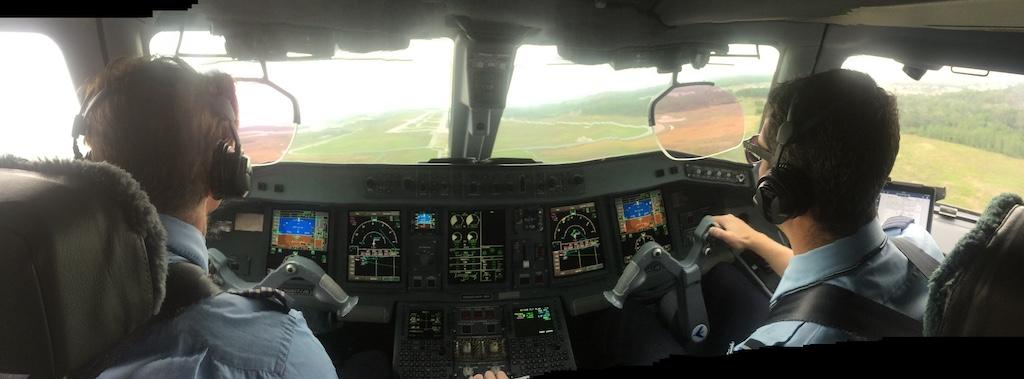
Most flightpath monitoring errors happen when the aircraft is in a dynamic state.
Last December, a United Airlines Boeing 777 departed Maui on a stormy afternoon. About 60 sec. after liftoff, the crew allowed the airplane pitch attitude to decrease from 12 ½ deg. nose up to 16 deg. nose down over the next 23 sec. The airplane descended from 2,100 ft. above ground level (AGL), reaching a maximum descent rate of 8,500 ft. per minute and a height of just 748 ft. above the water. With the enhanced ground proximity warning system (E-GPWS) blaring “Sink Rate! Pull Up! Too Low! Terrain!” the captain initiated the controlled flight into terrain (CFIT) escape maneuver. Disaster was averted by mere seconds.
This widely publicized event caught the attention of NTSB, which found the probable cause to be "the flight crew’s failure to manage the airplane’s vertical flightpath, airspeed and pitch attitude following a miscommunication about the captain’s desired flap setting during the initial climb."
The NTSB report and the associated background material does not provide much more detail about what was going on within that flight deck. However, one thing is for sure: The crew, at least momentarily during a critically important regime of flight, was not monitoring the flightpath of the 777.
The notion of pilots not adequately monitoring flightpath is not new. Almost 50 years to the day before this United incident, Eastern Airlines Flight 401 crashed into the Florida Everglades. The crew apparently became absorbed with attempting to replace a faulty landing gear indicator light. Because of their preoccupation, the crew did not realize the autopilot was no longer maintaining the set altitude. The Lockheed 1011 descended into the dark, featureless terrain of the Everglades. Ninety-nine lives were lost.
In the 50 years between these two events, there have been scores of other accidents, along with countless events such as altitude deviations, runway incursions and speed deviations that have resulted from pilots not paying attention to where the aircraft was headed. I started researching flightpath monitoring in 1997 as a research consultant for NASA’s Aviation Safety Reporting System, and I even wrote my Master’s thesis on this subject.
In 2002, I convinced the FAA to change the term “pilot not flying” to “pilot monitoring” to draw attention to the critical task of flightpath monitoring. The idea was simple: It is important to describe the pilot’s title by what he or she should be doing instead of what he or she is not doing. The FAA agreed and revised two advisory circulars to reflect this change. Aircraft manufacturers soon followed, as did many airlines and business aviation operators.
Last year, the FAA published advisory circular AC-120-123, “Flightpath Management.” According to that document, flightpath refers to the “trajectory (lateral, longitudinal and vertical) and energy state of the aircraft.” The term also includes ground path when the airplane is moving on the ground. “Ensuring that the aircraft is on a safe and correct flightpath is the highest priority of all pilots on the flight crew,” states the document. “Ensuring the airplane is on the correct flightpath includes the actions necessary to check/verify that the flightpath is correct and to intervene as necessary if it is not correct.”
In truth, research in several disciplines has shown that humans are not great at monitoring highly automated, highly reliable systems for extended periods of time. Yet, that’s precisely what pilots are expected to do. Like other aspects of aviation, however, monitoring is a skill that can be taught and perfected. Following a Cessna 560 crash in Pueblo, CO, while serving as vice chairman of the NTSB, I pushed the agency NTSB to issue a safety recommendation for FAA to require that pilot training programs teach and emphasize monitoring skills and workload management. In 2013, FAA published a rule that requires pilot monitoring training for Part 121 operators. Although I approved closing the recommendation once FAA made this regulatory change, as I sit here today, I see an irony: That NTSB recommendation, A-07-13, was issued at a result of a business aviation crash. However, the FAA’s response only covers Part 121 operators.
Research has shown that most flightpath monitoring errors are manifested when the aircraft is in a dynamic state, such as changes in altitude, speed or course. Therefore, strategies can be built around enhancing flightpath monitoring during these phases. “A Practical Guide For Improving Flight Path Monitoring,” published by the Flight Safety Foundation, refers to these phases as “areas of vulnerability” (AOV). These are flight regimes where “either the potentially increased likelihood of a flight path [sic] deviation or the increased severity of potential consequences if such a deviation occurs,” the publication says.
Knowing that you are more likely to have a flightpath deviation in these AOVs is significant. You should use enhanced monitoring during the AOVs and plan your workload to avoid doing non-monitoring tasks during these flight regimes. Think of it as making sure you are not doing the right things at the wrong time. For example, briefing the approach is something that we must do. When should it be done? It is best to perform this task prior to leaving cruise altitude—when possible—to increase flightpath monitoring capability. This allows greater attention to be devoted to properly monitoring the descent because the crew is not having to divide attention between reviewing the approach and monitoring the descent.
Many altitude deviations occur because pilots are not properly monitoring the level-off. After a few altitude deviations early in my career, I employed the technique of suspending non-monitoring tasks during the last 1,000 ft. of altitude change. That allowed my focus to make sure the airplane leveled at the proper altitude.
Lastly, remember that one pilot must always be monitoring the flight path—no matter what. When a distraction or malfunction occurs, the tendency is to focus on that issue. Resist that urge, and first make sure that one pilot is designated to monitor the flight instruments. One attention trap is the flight management system (FMS). I have noticed that when one pilot goes heads-down to program the box, the tendency is for the other pilot to watch. I once heard the late Earl Wiener, who conducted early research on automated aircraft, compare the FMS to a vacuum cleaner. “It sucks attention, fingers and eyeballs right into it,” he quipped.
Ask yourself: How are you doing with flightpath monitoring? Take a look through the Flight Safety Foundation monitoring guide and AC-120-123. Weigh up those words of wisdom against how you conduct your operations





